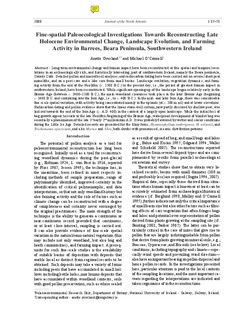| dc.identifier.citation | Overland, A., O'Connell, M. (2008). Fine-spatial paleoecological investigations towards reconstructing late holocene environmental change, landscape evolution, and farming activity in Barrees, Beara peninsula, southwestern Ireland. Journal of the North Atlantic, 1, 37-73 | no_NO |
| dc.description.abstract | Long-term environmental change and human impact have been reconstructed at fi ne spatial and temporal resolutions
in an archaeologically rich, and fl oristically interesting, part of southwestern Ireland, namely the Beara peninsula,
County Cork. Detailed pollen and macrofossil analyses, and radiocarbon dating have been carried out on several short peat
monoliths, and on a peat core and a lake core from small basins. Landscape evolution, vegetation dynamics, and farming
activity from the end of the Neolithic (c. 2500 B.C.) to the present day, i.e., the period of greatest human impact in
southwestern Ireland, have been reconstructed. While signifi cant opening-up of the landscape began relatively early in the
Bronze Age (between c. 2400–2100 B.C.), the main woodland clearances took place in the later Bronze Age (beginning
c. 1400 B.C. and continuing into the Iron Age, i.e., to c. 400 B.C.). In the mid- and later Iron Age, there was considerable
fi ne-scale spatial variation, with activity being concentrated mainly in the uplands (at c. 200 m asl) and at lower elevations.
Radiocarbon dating and pollen evidence show that the linear stone-wall system, now partly obscured by shallow peat, was
laid out towards the end of the Iron Age (c. A.D. 400) in the context of a largely open landscape. While the initial foci of
bog growth appear to relate to the late Neolithic/beginning of the Bronze Age, widespread development of blanket bog was
essentially a phenomenon of the late 1st/early 2nd millennium A.D. It was probably favoured by wetter and cooler conditions
during the Little Ice Age. Detailed records are presented for the fi lmy ferns, Hymenophyllum tunbrigense, H. wilsonii, and
Trichomanes speciosum, and also Myrica and Ulex, both shrubs with pronounced, oceanic distribution patterns. | no_NO |
